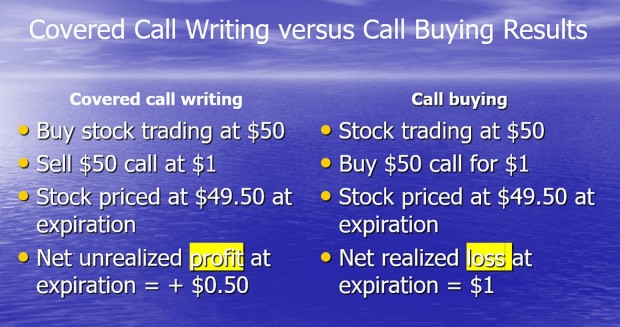Many assume that covered call writing is a zero sum game because we have traders executing equal but opposite trades using the same underlying security. As a covered call writer, we may sell 5 contracts of AAPL which means there is a buyer out there who just bought our contracts. If we win, they lose and vice-versa, right? Well, let’s examine, the Blue Collar way. We will set up two hypothetical scenarios, first for naked options and then for covered call writing and see if either can be viewed as a zero sum game.
Hypothetical trade scenario
- BCI is trading at $50.00
- The $50.00 at-the-money call is priced at $1.00
- The stock price moves up to $53.00 (scenario I)
- The stock price moves down to $47.00 (scenario II)
Naked option trading: Stock price moves up to $53.00 by expiration
The call buyer paid $1.00 for the option which is now worth $3.00 in intrinsic value resulting in a profit of $2.00. The call seller generated an initial profit of $1.00 and now is required to either buy back the option for $3.00 (plus a small time value premium) or buy the shares at $53.00 to deliver them at $50.00. Either way, there is a net loss of at least $2.00. This scenario does appear to be a zero sum game given no exit strategy execution and leaving both positions until contract expiration.
Naked option trading: Stock price moves down to $47.00 by expiration by expiration
The call buyer paid $1.00 for the option which expires worthless resulting in a loss of $1.00. The call seller generated $1.00 from the sale of the option which expires worthless resulting in a net profit of $1.00. Once again, given no position management maneuvers and allowing the trades to last until expiration, this does appear to be a zero sum game.
Covered call writing: Stock price moves up to $53.00 by expiration
Assuming no exit strategy executions, the call writer generates a profit of $1.00 on the sale of the option and shares are sold at $50.00, the price paid for the stock, netting a profit of $1.00. The call buyer paid $1.00 for the option which is now worth $3.00 in intrinsic value resulting in a net profit of $2.00. This does not appear to be a zero sum game.
Covered call writing: Stock price moves down to $47.00 by expiration
The covered call writer generates an initial profit of $1.00 on the sale of the option and has an unrealized share loss of $3.00, resulting in an unrealized loss of $2.00. The option buyer paid $1.00 for the option which expires worthless resulting in a loss of $1.00 again telling us that covered call writing is not a zero sum game.
Is it possible for one position to make money and the other to lose money?
Yes, if share price moves down less than the option premium originally generated, the covered call writer will make a profit while the naked option buyer will be in a losing position. Let’s say share prices declines to $49.50. The covered call writer will have a net credit of $0.50 per share or $50.00 per contract. The option buyer will lose the $1.00 paid for the option which expires worthless.

Discussion
This article was inspired by several of our members who inquired about zero sum games and offered different perspectives on their opinions regarding the topic. This article offers a mathematical perspective. Most options are closed and so only a small percentage actually last to expiration. Also, many option traders have an arsenal of position management techniques that will mitigate losses and enhance gains. A fair takeaway would be that naked option trading with positions left until expiration can reflect a zero sum game while covered call writing does not.
Market tone
Global stocks were little changed on the week withstanding presidential elections in France and South Korea and political turbulence in Washington. West Texas Intermediate crude oil rose modestly to $47.50 a barrel from last week’s $45.50. This week’s reports and international news of importance:
- President Donald Trump’s health care reform and tax cut agenda have faced significant legislative challenges and those headwinds stiffened considerably after the president removed from office Federal Bureau of Investigation director James Comey
- Centrist Emmanuel Macron was expected to easily beat right-wing populist Marine Le Pen in the second round of the French presidential election, but his margin of victory proved to be even larger than expected. Macron received 66% of the vote to Le Pen’s 34%. He must now forge a governing majority in the National Assembly, with two-round parliamentary elections scheduled for June 11th and June 18th
- Newly-elected South Korean president Moon Jae-in took office on Wednesday and vowed to resolve the security crisis on the Korean peninsula as soon as possible, including by traveling to Pyongyang, under the right conditions
- On the economic front, Moon is expected to push for the reform of South Korea’s conglomerate system, as well as to seek higher corporate taxes
- Volatility, as measured by the Chicago Board Options Exchange Index (VIX), fell to its lowest level since 1993 this week amid unusually calm equity trading conditions. The VIX, at 10.40 is running at roughly half of its twenty-year average, according to Reuters
- Concerns over the sustainability of Greek debt have caused in the International Monetary Fund to bypass the past several rounds of funding for the indebted eurozone member. But the IMF looks likely to rejoin the bailout in the weeks ahead, and continues to push European authorities to grant Greece debt relief. An agreement is expected at a meeting of Eurogroup finance ministers on May 22nd
- US retail sales expanded at the fastest rate in three months in April, while prior months’ data were revised higher. Strong labor markets and modestly rising wages are supporting consumption
- Consumer prices in the US remain subdued, rising 0.2% in April after falling 0.3% in March
- Core CPI rose 0.1% in April, and was up 1.9% versus a year ago
- The Bank of England left interest rates unchanged at their rate-setting meeting on Thursday but the Monetary Policy Committee slightly downgraded its economic growth forecast for 2017 to 1.9% from an earlier 2% outlook
THE WEEK AHEAD
MONDAY, May 15th
Home builders’ index May
TUESDAY, MAY 16th
Housing starts April
Building permits April
Industrial production April
WEDNESDAY, MAY 17
None scheduled
THURSDAY, MAY 18
Philly Fed index May
Leading indicators April
FRIDAY, MAY 19
Advance services report
For the week, the S&P 500 declined by 0.35% for a year-to-date return of6.79%.
Summary
IBD: Market in confirmed uptrend
GMI: 5/6- Buy signal since market close of April 21, 2017
BCI: I am currently cautiously bullish, favoring out-of-the-money strikes 3-to-2.
WHAT THE BROAD MARKET INDICATORS (S&P 500 AND VIX) ARE TELLING US
The 6-month charts point to a moderately bullish outlook. In the past six months, the S&P 500 was up 10% while the VIX (10.40) declined by 28%.
